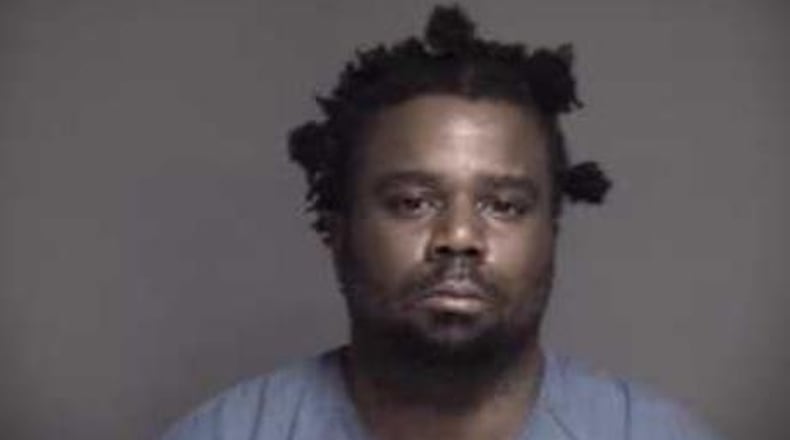Barron is charged with trafficking in persons, the Ohio version of laws passed around the U.S. and world to fight human trafficking.
“When most people think of human trafficking, they think of groups of young females being kidnapped, perhaps internationally, and sold around the country/world. Those situations do occur, but the much more frequent occurrence is what we see in the Barron case,” Warren County Prosecutor David Fornshell said.
Barron is also charged with promoting prostitution, abduction, aggravated possession of drugs, receiving stolen property, aggravated menacing, intimidation of a crime victim or witness, felonious assault and corrupting another with drugs.
A police investigation alleges the victims were being trafficked through on-line advertising.
“He was essentially forcing them to do this through threats and actual beatings,” Fornshell said.
Barron remained in the Warren County Jail on $500,000 bond, following his arraignment Wednesday in Warren County Common Pleas Court.
MORE: More than 100 arrested in Ohio child sex trafficking sting
“Individuals prey on vulnerable victims, perhaps provide them housing or drugs, and then once the victims become dependent, they are beaten, threatened, and isolated from family and friends unless they engage in prostitution for these individuals. Their bodies are literally trafficked against their will. And it happens every day, in probably almost every county in our country,” Fornshell added in email responses.
The case against Barron began when he was pulled over by Mason police near Kings Island at Ohio 741 and Beach Boulevard, the road into the water park across Interstate 741 from the amusement park on May 2 for traffic violations.
In the car, police reportedly found two pipes used to smoke methamphetamine and other drug paraphernalia, along with 280 grams of marijuana in nine baggies for distribution.
MORE: Springboro case shines light on human trafficking
His court-appointed lawyer could not be reached for comment.
Ohio human trafficking law, first enacted in 2011, was last updated last year.
Other local cases have involved victims from elsewhere and movements across criminal jurisdictions and state lines.
In January 2019, an off-duty Springboro police officer smelled marijuana while walking his dog at E. Milo Beck Park in Springboro.
A 14-year-old girl from Orlando, Fla., told Springboro police her ordeal began when she was forced to leave Orlando in August with an ex-boyfriend and ended when she was found in the park.
On-duty officers found the girl and a 24-year-old South American man in the park parking lot. He told police he met the girl through a dating app, took her to Indiana, provided her a hotel room in Springdale, a Cincinnati suburb; and breakfast at Chipotle before heading to Beck Park to get high.
The girl, identified in a Dec. 20, 2018 notice by The National Center for Missing and Exploited Children, was released to Florida authorities on Jan. 29, 2019, according to Warren County Juvenile Court records reviewed today by the Dayton Daily News.
The man, Lukas Serrano, 23, was fined $100 for contributing to her delinquency and permitted to continue onto Europe and back home to Columbia, according to court records.
RELATED: Columbian man fined $100 for role in human-trafficking case
The case was turned over to federal authorities. The outcome was unclear.
Human trafficking is “believed to be the third-largest criminal activity in the world,” according to an on-line FBI statement. “Here in this country, people are being bought, sold, and smuggled like modern-day slaves, often beaten, starved, and forced to work as prostitutes or to take jobs as migrant, domestic, restaurant or factory workers with little or no pay.”
Last year, a University of Cincinnati study determined there were more than 1,000 victims of human trafficking in Ohio.
The study, led by Assistant Professor Valerie Anderson, “Estimating the Prevalence of Human Trafficking in Ohio,” examined data from 14 sources, including child welfare, law enforcement, legal and juvenile justice records during 2014-2016.
An estimated 1,032 victims were identified, with another 4,209 considered to be at risk of trafficking victimization during the same period.
“The victims of human trafficking typically have some kind of issue going on in their lives,” Fornshell said, such as drug addiction or homelessness.
In this case, the victims were allegedly being provided drugs by Harron.
“He was trafficking them daily multiple, multiple times,” the prosecutor said.
The human trafficking began in March and ended with Harron’s arrest, according to Fornshell.
“The type of human trafficking we are talking about is probably the most prevalent human trafficking you see,” Fornshell said.
The state law was rewritten in response to “this precise type of conduct,” Fornshell added.
About the Author

